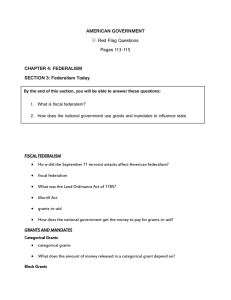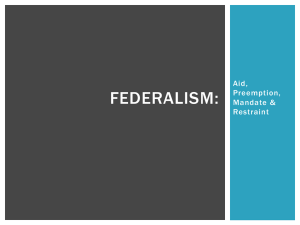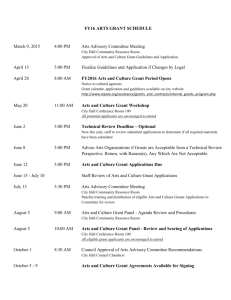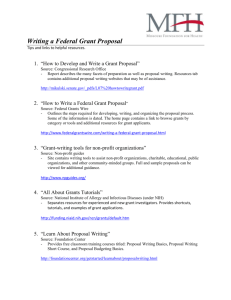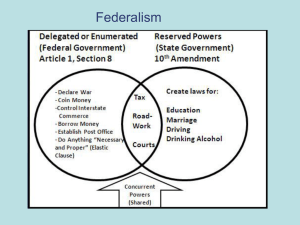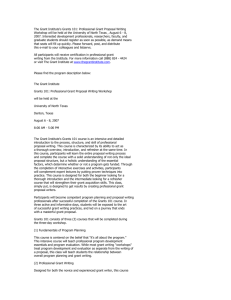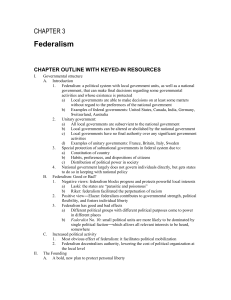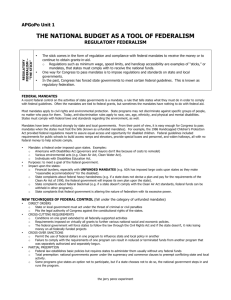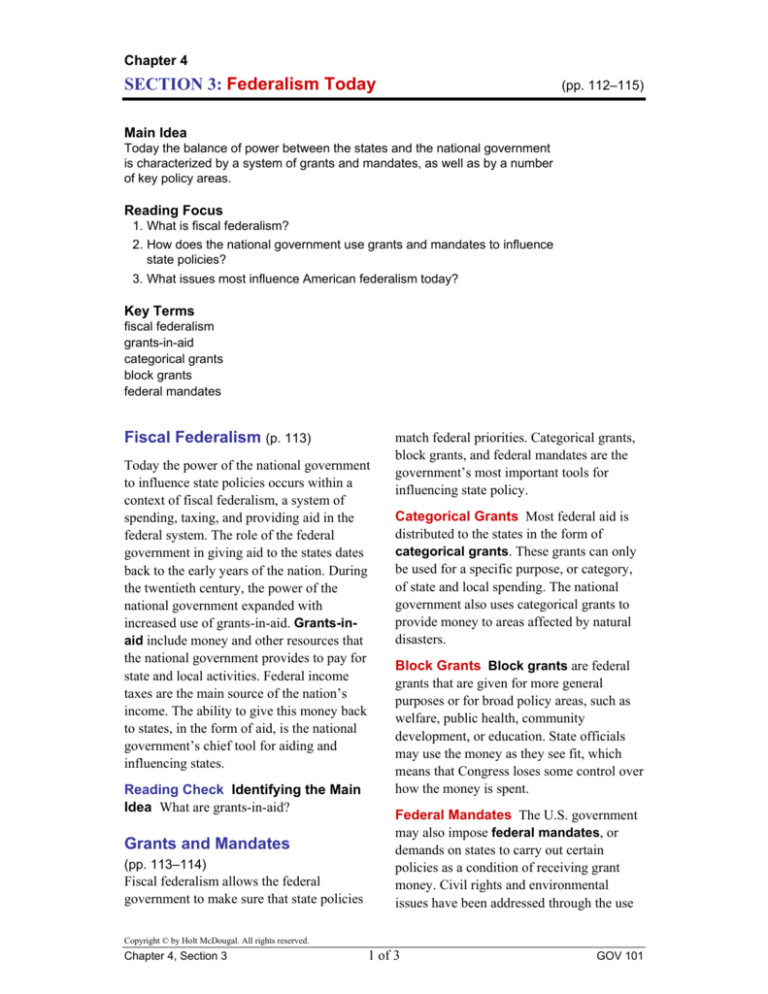
Chapter 4
SECTION 3: Federalism Today
(pp. 112–115)
Main Idea
Today the balance of power between the states and the national government
is characterized by a system of grants and mandates, as well as by a number
of key policy areas.
Reading Focus
1. What is fiscal federalism?
2. How does the national government use grants and mandates to influence
state policies?
3. What issues most influence American federalism today?
Key Terms
fiscal federalism
grants-in-aid
categorical grants
block grants
federal mandates
Fiscal Federalism (p. 113)
Today the power of the national government
to influence state policies occurs within a
context of fiscal federalism, a system of
spending, taxing, and providing aid in the
federal system. The role of the federal
government in giving aid to the states dates
back to the early years of the nation. During
the twentieth century, the power of the
national government expanded with
increased use of grants-in-aid. Grants-inaid include money and other resources that
the national government provides to pay for
state and local activities. Federal income
taxes are the main source of the nation’s
income. The ability to give this money back
to states, in the form of aid, is the national
government’s chief tool for aiding and
influencing states.
Reading Check Identifying the Main
Idea What are grants-in-aid?
Grants and Mandates
(pp. 113–114)
Fiscal federalism allows the federal
government to make sure that state policies
match federal priorities. Categorical grants,
block grants, and federal mandates are the
government’s most important tools for
influencing state policy.
Categorical Grants Most federal aid is
distributed to the states in the form of
categorical grants. These grants can only
be used for a specific purpose, or category,
of state and local spending. The national
government also uses categorical grants to
provide money to areas affected by natural
disasters.
Block Grants Block grants are federal
grants that are given for more general
purposes or for broad policy areas, such as
welfare, public health, community
development, or education. State officials
may use the money as they see fit, which
means that Congress loses some control over
how the money is spent.
Federal Mandates The U.S. government
may also impose federal mandates, or
demands on states to carry out certain
policies as a condition of receiving grant
money. Civil rights and environmental
issues have been addressed through the use
Copyright © by Holt McDougal. All rights reserved.
Chapter 4, Section 3
1 of 3
GOV 101
Chapter 4, Section 3 continued
alongside the Department of Homeland
Security to respond to the disaster. Many
people questioned the leadership and
cooperation in the relief effort after the
disaster.
of federal mandates. In some cases,
Congress has even put in place “unfunded
mandates,” or demands without funding.
States tend to argue against unfunded
mandates, saying that they should not have
to pay for something that they did not
approve.
Environment Protecting the environment
is often seen as the role of the national
government. Some people believe they
could be better handled at the state and local
level. As a result, some members of
Congress have asked to limit the role of the
federal Environmental Protection Agency in
favor of local recycling and conservation
efforts.
Reading Check Making
Generalizations What types of federal
aid might the states generally prefer? Why?
Issues in Federalism Today (pp.
114–115)
New issues challenge the American
federalist system today. Political debates
over how the United States should address
poverty, homeland security, environmental
protection, immigration, and health care
drive changes in our federal system.
Immigration The national government
typically handles immigration issues.
However, states with international borders
often take on responsibility for a number of
immigration-related issues, such as
increased health-care costs and education.
Congress continues to debate immigration
reforms but has yet to resolve the issue on
the national level.
Poverty In 1996 Congress passed a
welfare reform law that gave the states the
authority to manage their own welfare
systems using federal block grants. Since
that time, the number of people on welfare
has decreased. Debate over the reason for
this change continues. Some people believe
it is because states have greater creativity
and flexibility in creating programs for the
poor. Others argue that it is the result of a
strong economy. Whether states can
continue to meet the needs of the poor is an
ongoing question.
Homeland Security Protecting the nation
from terrorism, natural disasters, and other
emergencies is the job of the Department of
Homeland Security. The department was
created after the 2001 terrorist attacks.
When Hurricane Katrina hit the Gulf Coast
in 2005, local and state governments worked
Health Care Americans are increasingly
looking to the government for solutions to
health care problems such as the rising costs
of services and insurance. In 2003 as many
as 45 million Americans did not have health
insurance. If Americans cannot afford to pay
for their own health care, should the
government pick up the tab? Which level of
government should take the lead—state or
national? The answers to these questions
will no doubt redirect the course of
American federalism in the years to come.
Reading Check Summarizing What
are some of the issues affecting the
federalist system today?
SECTION 3 ASSESSMENT
1. Define What are grants-in-aid?
Copyright © by Holt McDougal. All rights reserved.
Chapter 4, Section 3
2 of 3
GOV 101
Chapter 4, Section 3 continued
2. Identify For what purposes are categorical grants used?
3. Identify How has welfare reform affected the way state and national governments work
together to fight poverty?
Copyright © by Holt McDougal. All rights reserved.
Chapter 4, Section 3
3 of 3
GOV 101

